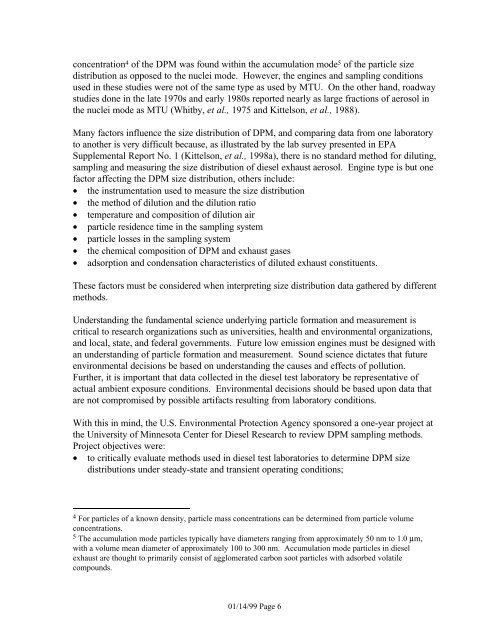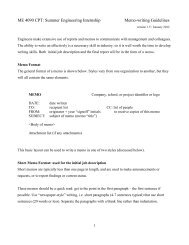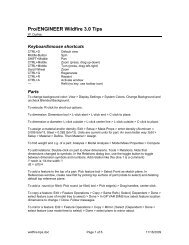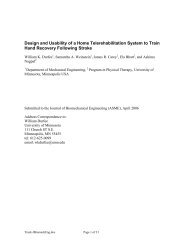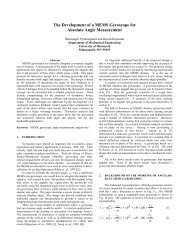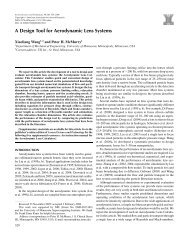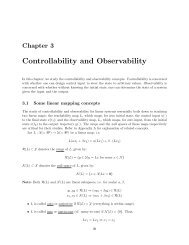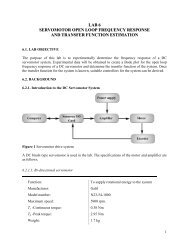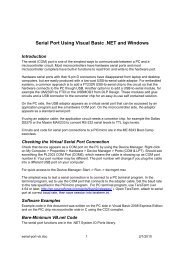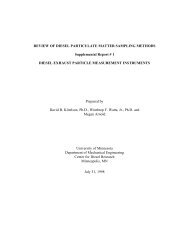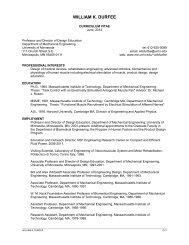Review of diesel particulate matter sampling - Department of ...
Review of diesel particulate matter sampling - Department of ...
Review of diesel particulate matter sampling - Department of ...
Create successful ePaper yourself
Turn your PDF publications into a flip-book with our unique Google optimized e-Paper software.
concentration 4 <strong>of</strong> the DPM was found within the accumulation mode 5 <strong>of</strong> the particle size<br />
distribution as opposed to the nuclei mode. However, the engines and <strong>sampling</strong> conditions<br />
used in these studies were not <strong>of</strong> the same type as used by MTU. On the other hand, roadway<br />
studies done in the late 1970s and early 1980s reported nearly as large fractions <strong>of</strong> aerosol in<br />
the nuclei mode as MTU (Whitby, et al., 1975 and Kittelson, et al., 1988).<br />
Many factors influence the size distribution <strong>of</strong> DPM, and comparing data from one laboratory<br />
to another is very difficult because, as illustrated by the lab survey presented in EPA<br />
Supplemental Report No. 1 (Kittelson, et al., 1998a), there is no standard method for diluting,<br />
<strong>sampling</strong> and measuring the size distribution <strong>of</strong> <strong>diesel</strong> exhaust aerosol. Engine type is but one<br />
factor affecting the DPM size distribution, others include:<br />
• the instrumentation used to measure the size distribution<br />
• the method <strong>of</strong> dilution and the dilution ratio<br />
• temperature and composition <strong>of</strong> dilution air<br />
• particle residence time in the <strong>sampling</strong> system<br />
• particle losses in the <strong>sampling</strong> system<br />
• the chemical composition <strong>of</strong> DPM and exhaust gases<br />
• adsorption and condensation characteristics <strong>of</strong> diluted exhaust constituents.<br />
These factors must be considered when interpreting size distribution data gathered by different<br />
methods.<br />
Understanding the fundamental science underlying particle formation and measurement is<br />
critical to research organizations such as universities, health and environmental organizations,<br />
and local, state, and federal governments. Future low emission engines must be designed with<br />
an understanding <strong>of</strong> particle formation and measurement. Sound science dictates that future<br />
environmental decisions be based on understanding the causes and effects <strong>of</strong> pollution.<br />
Further, it is important that data collected in the <strong>diesel</strong> test laboratory be representative <strong>of</strong><br />
actual ambient exposure conditions. Environmental decisions should be based upon data that<br />
are not compromised by possible artifacts resulting from laboratory conditions.<br />
With this in mind, the U.S. Environmental Protection Agency sponsored a one-year project at<br />
the University <strong>of</strong> Minnesota Center for Diesel Research to review DPM <strong>sampling</strong> methods.<br />
Project objectives were:<br />
• to critically evaluate methods used in <strong>diesel</strong> test laboratories to determine DPM size<br />
distributions under steady-state and transient operating conditions;<br />
4 For particles <strong>of</strong> a known density, particle mass concentrations can be determined from particle volume<br />
concentrations.<br />
5 The accumulation mode particles typically have diameters ranging from approximately 50 nm to 1.0 μm,<br />
with a volume mean diameter <strong>of</strong> approximately 100 to 300 nm. Accumulation mode particles in <strong>diesel</strong><br />
exhaust are thought to primarily consist <strong>of</strong> agglomerated carbon soot particles with adsorbed volatile<br />
compounds.<br />
01/14/99 Page 6


